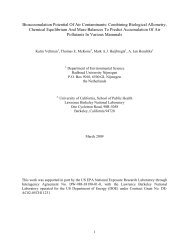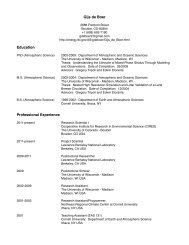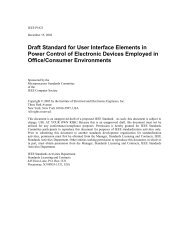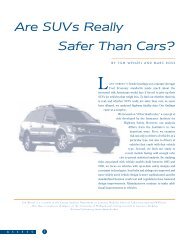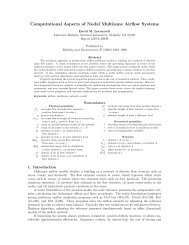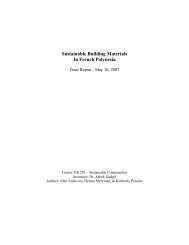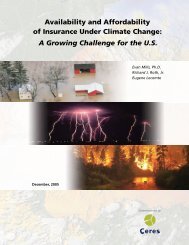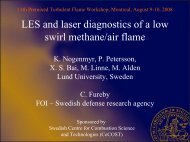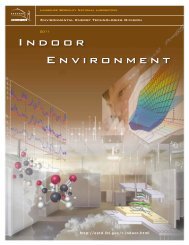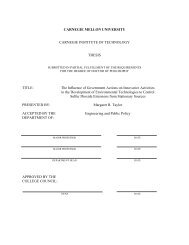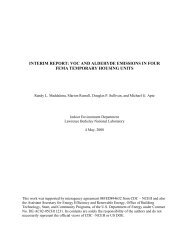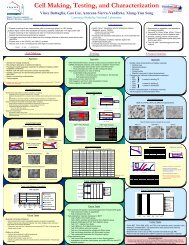indoor-outdoor air leakage of apartments and commercial buildings
indoor-outdoor air leakage of apartments and commercial buildings
indoor-outdoor air leakage of apartments and commercial buildings
You also want an ePaper? Increase the reach of your titles
YUMPU automatically turns print PDFs into web optimized ePapers that Google loves.
L/ s m 2 at 50 Pa, <strong>and</strong> a geometric st<strong>and</strong>ard deviation (GSD) <strong>of</strong> about 2.3. Figure 1 shows a<br />
histogram <strong>of</strong> the distribution <strong>of</strong> the logarithms (base 10) <strong>of</strong> the data.<br />
0<br />
r-<br />
0<br />
(D<br />
0<br />
l{)<br />
(/J<br />
0><br />
C<br />
:2 0<br />
·s '¢<br />
0)<br />
(3<br />
Q; 0<br />
.0 (')<br />
E<br />
::l<br />
Z<br />
0<br />
0J<br />
0<br />
0.3 1 3 10 30<br />
Air Flow at 50 Pa [Liters per second per square meter]<br />
Figure 1 Histogram <strong>of</strong> <strong>air</strong> flow (liters per second per square meter <strong>of</strong> building shell) at 50 Pa <strong>indoor</strong><br />
<strong>outdoor</strong> pressure difference, for the 267 <strong>buildings</strong> in the <strong>commercial</strong> <strong>buildings</strong> database. These data do<br />
not constitute a representative sample <strong>of</strong> all <strong>commercial</strong> <strong>buildings</strong>. The distribution is approximately<br />
lognormal, with a geometric mean (GM) <strong>of</strong> 4 LIs m 2 <strong>and</strong> a geometric st<strong>and</strong>ard deviation (GSD) <strong>of</strong> 2.3.<br />
By contrast with the <strong>commercial</strong> building distribution, our recent analysis <strong>of</strong> the <strong>air</strong><br />
<strong>leakage</strong> <strong>of</strong> US single-family houses (Chan et al. 2005) found that the <strong>leakage</strong> follows a<br />
lognormal distribution with a GM <strong>of</strong> 2.6 L/ (s·m 2 ), <strong>and</strong> a GSD <strong>of</strong> 1.6, at a 50 Pa <strong>indoor</strong>-<strong>outdoor</strong><br />
pressure difference. Thus, based on this cursory summary <strong>of</strong> the data, <strong>commercial</strong> <strong>buildings</strong><br />
seem to be somewhat leakier than single-family houses, <strong>and</strong> also to have leakiness that is more<br />
variable than single-family homes.<br />
Based on the published information about the <strong>buildings</strong> that were measured, we<br />
classified each building according to usage (e.g. school, retail, etc.) <strong>and</strong> construction type<br />
(masonry, steel frame, etc.). "Manufactured building" refers to trailers or portable structures.<br />
Inevitably, there is some ambiguity in the classification <strong>of</strong> building usage <strong>and</strong> construction<br />
types. Our classifications are based on those used in the original studies, but we had to interpret<br />
some entries that did not perfectly match any <strong>of</strong> our categories. Table 2 summarizes the number<br />
<strong>of</strong> <strong>buildings</strong> in each classification <strong>and</strong> construction type, <strong>and</strong> the fraction <strong>of</strong> the total database<br />
18



